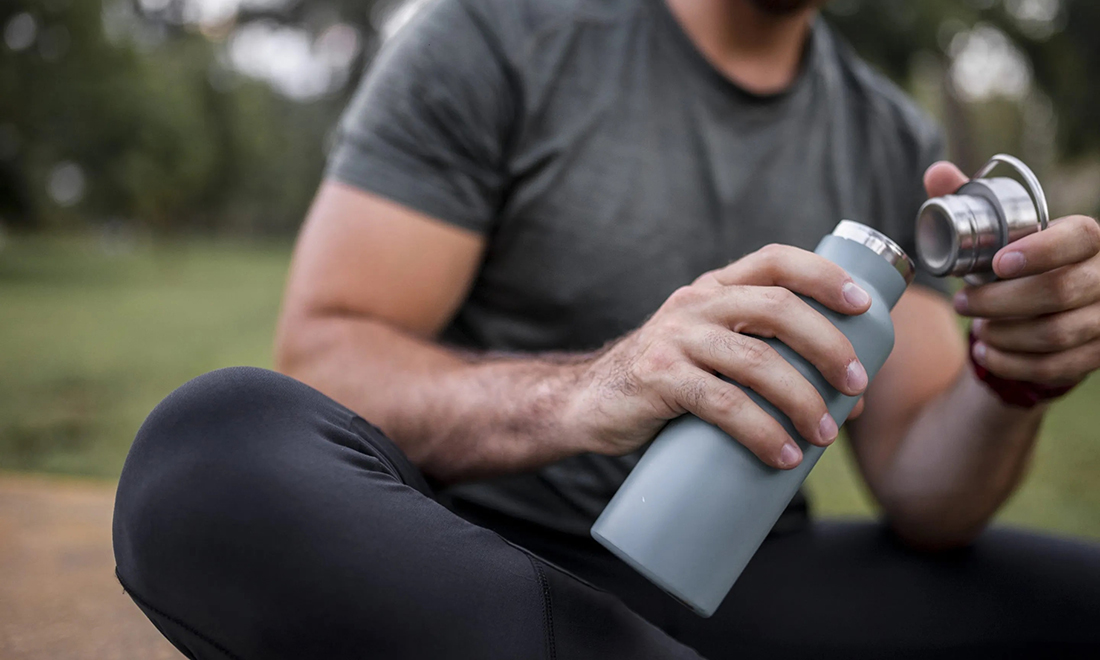
和許多人一樣,卡爾·貝恩克(Carl Behnke)每天都會隨身攜帶水瓶,以確保自己能及時補充水分。從辦公室到健身房,再返回家中,貝恩克幾乎時刻都不離其左右。但貝恩克同時也是普渡大學(Purdue University)酒店與旅游管理學院的副教授,他在清洗水瓶時發現水瓶內壁上有一層“生物膜”,這不禁令他陷入沉思。他解釋道:“我意識到自己在清洗水瓶方面,或許并未達到應有的認真程度。這使我心生好奇:對于了解食品安全的人來說尚且如此,其他人又會怎樣呢?”
這個問題促使貝恩克和一批學者及科學家開展了一項研究,旨在探究可重復使用水瓶的污染程度如何受到使用和清潔行為的影響。如果你經常使用可重復使用水瓶飲水,那么他們的研究成果或許會讓你重新審視自己清潔水瓶的方式。
改變習慣
雖然整天隨身攜帶可重復使用水瓶對健康和環境都有益,但忽視對它的清潔則可能會導致一些不良后果。貝恩克問道:“你會在晚飯后清洗餐具嗎?答案是確定的,但對于水瓶,我們經常把它們帶到各處,卻未能妥善清潔。”
你可能會把水瓶沖洗干凈,但倘若未能按照應有的頻率進行恰當清洗,那么對于瓶子表面及內部可能滋生的細菌,你會倍感驚詫。這項研究包括兩部分調查問卷,由水瓶使用者填寫。第一組問題主要涉及使用的水瓶類型、使用年限、瓶內所盛之物(水、能量飲料等)以及使用頻率。第二部分則側重于清潔行為,包含從清潔方法到清潔頻率等方面。
貝恩克說,從根本上說,典型的水瓶使用方式具備了滋生細菌的所有條件:潮濕、污染以及通常處于較高溫度環境。貝勒醫學院(Baylor College of Medicine)傳染病醫學助理教授福田由里子(Yuriko Fukuta)博士對此表示贊同。她說:“我們頻繁地用嘴和手接觸水瓶,因此極易將細菌傳播給水瓶,然后細菌就會滋生。在某些情況下,這可能會讓你生病,尤其是當你的免疫系統較弱時。”
福田指出,細菌可能包含葡萄球菌或鏈球菌。而該項合作研究還表明:“我們的樣本中,有超過20%的樣本含有大腸桿菌,也就是糞便污染滋生的細菌,”貝恩克說。
水瓶的正確護理和清潔方法
倘若瓶內的細菌讓你想要正確對待水瓶,以下是一些應遵循的注意事項:
? 僅在瓶內裝水,以減少細菌滋生。能量飲料、茶或其他粉末及添加劑只會增加細菌滋生的幾率。
? 避免將水瓶置于可能升溫的區域。福田表示:“切勿將水瓶留置車內,而后飲用其中的水。高溫與時間會加速細菌的滋生。”
? 貝恩克建議,每日使用后對水瓶進行沖洗。
? 每周進行一次徹底清潔,最好用專門的瓶刷手工清洗。清潔完畢后,將其倒置在晾干架上直至完全晾干——切勿將潮濕的瓶子收起來。
? 避免與他人共用水瓶。貝恩克表示:“若僅是你的唾液與水,問題不大。但倘若與他人共用,會引入其他污染物。”
減少細菌滋生的最佳水瓶類型
福田認為,最佳選擇是寬口瓶,這樣的水瓶易于清洗和晾干,以及帶有內置吸管的水瓶,可以盡可能地避免手接觸瓶口。
如果你旨在防止水瓶淪為細菌滋生的溫床,最為簡便的方法就是貝恩克在進行研究后所采用方式。他說道:“我每天用水沖洗一次水瓶,每周使用優質洗滌劑、瓶刷和高樂氏(Clorox)漂白水清洗一次。”(財富中文網)
譯者:中慧言-王芳
和許多人一樣,卡爾·貝恩克(Carl Behnke)每天都會隨身攜帶水瓶,以確保自己能及時補充水分。從辦公室到健身房,再返回家中,貝恩克幾乎時刻都不離其左右。但貝恩克同時也是普渡大學(Purdue University)酒店與旅游管理學院的副教授,他在清洗水瓶時發現水瓶內壁上有一層“生物膜”,這不禁令他陷入沉思。他解釋道:“我意識到自己在清洗水瓶方面,或許并未達到應有的認真程度。這使我心生好奇:對于了解食品安全的人來說尚且如此,其他人又會怎樣呢?”
這個問題促使貝恩克和一批學者及科學家開展了一項研究,旨在探究可重復使用水瓶的污染程度如何受到使用和清潔行為的影響。如果你經常使用可重復使用水瓶飲水,那么他們的研究成果或許會讓你重新審視自己清潔水瓶的方式。
改變習慣
雖然整天隨身攜帶可重復使用水瓶對健康和環境都有益,但忽視對它的清潔則可能會導致一些不良后果。貝恩克問道:“你會在晚飯后清洗餐具嗎?答案是確定的,但對于水瓶,我們經常把它們帶到各處,卻未能妥善清潔。”
你可能會把水瓶沖洗干凈,但倘若未能按照應有的頻率進行恰當清洗,那么對于瓶子表面及內部可能滋生的細菌,你會倍感驚詫。這項研究包括兩部分調查問卷,由水瓶使用者填寫。第一組問題主要涉及使用的水瓶類型、使用年限、瓶內所盛之物(水、能量飲料等)以及使用頻率。第二部分則側重于清潔行為,包含從清潔方法到清潔頻率等方面。
貝恩克說,從根本上說,典型的水瓶使用方式具備了滋生細菌的所有條件:潮濕、污染以及通常處于較高溫度環境。貝勒醫學院(Baylor College of Medicine)傳染病醫學助理教授福田由里子(Yuriko Fukuta)博士對此表示贊同。她說:“我們頻繁地用嘴和手接觸水瓶,因此極易將細菌傳播給水瓶,然后細菌就會滋生。在某些情況下,這可能會讓你生病,尤其是當你的免疫系統較弱時。”
福田指出,細菌可能包含葡萄球菌或鏈球菌。而該項合作研究還表明:“我們的樣本中,有超過20%的樣本含有大腸桿菌,也就是糞便污染滋生的細菌,”貝恩克說。
水瓶的正確護理和清潔方法
倘若瓶內的細菌讓你想要正確對待水瓶,以下是一些應遵循的注意事項:
? 僅在瓶內裝水,以減少細菌滋生。能量飲料、茶或其他粉末及添加劑只會增加細菌滋生的幾率。
? 避免將水瓶置于可能升溫的區域。福田表示:“切勿將水瓶留置車內,而后飲用其中的水。高溫與時間會加速細菌的滋生。”
? 貝恩克建議,每日使用后對水瓶進行沖洗。
? 每周進行一次徹底清潔,最好用專門的瓶刷手工清洗。清潔完畢后,將其倒置在晾干架上直至完全晾干——切勿將潮濕的瓶子收起來。
? 避免與他人共用水瓶。貝恩克表示:“若僅是你的唾液與水,問題不大。但倘若與他人共用,會引入其他污染物。”
減少細菌滋生的最佳水瓶類型
福田認為,最佳選擇是寬口瓶,這樣的水瓶易于清洗和晾干,以及帶有內置吸管的水瓶,可以盡可能地避免手接觸瓶口。
如果你旨在防止水瓶淪為細菌滋生的溫床,最為簡便的方法就是貝恩克在進行研究后所采用方式。他說道:“我每天用水沖洗一次水瓶,每周使用優質洗滌劑、瓶刷和高樂氏(Clorox)漂白水清洗一次。”(財富中文網)
譯者:中慧言-王芳
Like many people, Carl Behnke regularly totes a water bottle around throughout his day to make sure he stays hydrated. From the office to the gym and back home again, Behnke is rarely without it. But Behnke is also an associate professor in the school of hospitality and tourism management at Purdue University, and when he discovered a “biofilm” on the inside of his water bottle while cleaning it, it got his wheels turning. “I realized I probably wasn’t as diligent about cleaning my water bottle as I should be,” he explains. “And that made me curious: If someone who knows about food safety isn’t diligent, what about everyone else?”
That question led to a study, conducted by Behnke and a cohort of academics and scientists, into how reusable-bottle contamination levels are affected by usage and cleaning behaviors. If you’re regularly drinking water from a reusable bottle, their findings might prompt you to reconsider your own water-bottle-handling practices.
Change your habits
While carrying around a reusable water bottle all day is healthy for you—and good for the environment—neglecting its care could lead to some negative consequences. “Do you wash your dishes after dinner?” asks Behnke. “Yes. But with water bottles, we often take them all over the place and don’t properly clean them.”
You might rinse your bottle out, but if you don’t wash it properly as often as you should, you’d be surprised at what might be growing on the surface and on the inside. The study consisted of two sections of surveys filled out by water-bottle users. The first set of questions centered on the type and age of bottle they used, what they put inside it (water, energy drinks, et cetera), and their frequency of use. The second section focused on cleaning behaviors, from the method to the frequency.
Essentially, said Behnke, typical water-bottle use has all the ingredients to foster bacterial growth: moisture, contamination, and, often, warm temperatures. Dr. Yuriko Fukuta, assistant professor of medicine–infectious diseases at Baylor College of Medicine, agrees. “We’re constantly touching our water bottles with our mouths and hands, so it’s easy to transmit bacteria to them, and then it just grows,” she says. “In some cases this can make you sick, especially if you have a weaker immune system.”
Fukuta suggested that bacteria might include staph or strep. And there’s this, from the cohort study: “More than 20% of our samples had coliform bacteria, which is fecal matter,” says Behnke.
Proper care and cleaning for water bottles
If all that bacteria has you wanting to do right by your water bottle, there are a few dos and don’ts to follow:
? Stick to just water in your bottles to lessen bacterial growth. Energy drinks, tea, or other powders and add-ins will only increase the likelihood of bacterial growth.
? Keep your water bottles out of spots where they might heat up. “Don’t leave your water bottle inside your car and then drink from it,” says Fukuta. “Warm temperatures and time accelerate the growth of germs.”
? Rinse it after every day’s use, recommends Behnke.
? Give it a good washing once a week, preferably by hand and with a special bottle brush. When finished, leave it upside down on a drying rack to dry completely—don’t put your bottles away wet.
? Avoid sharing water bottles with anyone else. “If it’s your saliva and just water, it’s not a big deal,” says Behnke. “But if you share, you’re introducing other contaminants.”
The best type of water bottle for mitigating bacterial growth
According to Fukuta, your best bets are bottles with a wide mouth, which make them easy to clean and dry, and those with a built-in straw that keeps your hands away if possible.
If your goal is to keep your water bottle from turning into a germy breeding ground, the simplest approach is Behnke’s, which he changed after conducting the research. “I rinse my bottle once a day,” he says, “and wash it once a week, using good detergent, a bottle brush, and a spray of Clorox bleach.”






